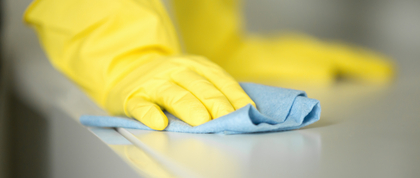
Greetings Students, Friends, and Colleagues:
Here's a summary of a New England Journal of Medicine article published recently that details how the Covid-19 virus survives on various materials. The biggest take home message is that metals and plastic surfaces (and, by extension, countertops and desks) can remain "contaminated" for days. Daily disinfecting of these surfaces is strongly recommended.
FOR AEROSOLS (What gets released from coughing -- fine airborne particles smaller than 5 microns; think of mists):
- A space with a coughing patient will contain aerosolized viral particles for at least three hours with a 97.5 percent reduction in 7.5 hrs. The virus (within an aerosol) can be transmitted through the air with the risk dependent on air currents.
- ADVICE: Entering a home where an infected person lived, days after they left, is probably OK. The virus is unlikely to be in the room air. The air released from opening shipping boxes is also unlikely to contain active viral particles. But entering a cab shortly after an infected, coughing person got out may infect you.
ON CARDBOARD (packaging, envelopes):
- Slower die-off on cardboard (i.e., it's a less hostile environment).
- The virus can live on cardboard (at active levels) for about 12 hours (97.5% reduction).
- After 24 hours, the levels on cardboard are low enough to safely handle packages suspected of contamination.
- ADVICE: Continue to hand-sanitize after handling mail and other paper products handled by others.
ON STAINLESS STEEL (SS) (handles, grips, doorknobs and other smooth materials made of metal):
- Much slower die-off on SS (i.e., it's a less hostile environment).
- The virus can live on SS at active levels for about 48 hours (two days).
- After 72 hours (three days), the levels on SS are below detectable levels.
- ADVICE: Continue to hand-sanitize after handling SS or metal objects suspected of being handled by infected people (i.e. subway handles, door knobs, etc).
ON PLASTIC (disposable utensils, plates, bottles, seating in cabs, etc.):
- Plastics have the highest longevity of all materials. (i.e., the least hostile environment).
- The virus can live on plastic (at active levels) for about 72 hours.
- After about 96 hours (four days), the levels on plastic are low enough to safely handle surfaces suspected of viral contamination.
- ADVICE: Continue to hand-sanitize after handling plastic surfaces that others have touched. Sanitize hard surfaces that people are likely to touch (desks, countertops, etc.) daily (and more often if in a public area)
Best wishes and be safe!

Jack Caravanos, DrPH
Clinical Professor of Environmental Public Health Sciences
How much do you know about the coronavirus?
Dr. Caravanos created the first of many COVID-19 quizzes to urge our students and future leaders to stay informed, correct misstatements, and bring the facts and science. Test your knowledge and take the quiz now!